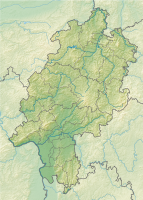Königsberg mine district
| Königsberg mine district | |||
|---|---|---|---|
| General information about the mine | |||
| Mining technology | Civil engineering | ||
| Funding / total | (1920-1949) 248,625 tons | ||
| Information about the mining company | |||
| Employees | Max. 49 men | ||
| Start of operation | circa 1664 | ||
| End of operation | 1949 | ||
| Funded raw materials | |||
| Degradation of | Roteisenstein | ||
| Greatest depth | 160 meters | ||
| Geographical location | |||
| Coordinates | 50 ° 38 '19 " N , 8 ° 31' 54" E | ||
|
|||
| local community | Biebertal | ||
| District ( NUTS3 ) | to water | ||
| country | State of Hesse | ||
| Country | Germany | ||
| District | Wetzlar | ||
The Königsberg mine was a mining operation in Biebertal near the Königsberg district near Gießen . A rich Roteisenstein deposit was mined there . It is one of the mines in the Lahn-Dill area .
Origin and history
The oldest documentary evidence of Königsberg iron ore mining can be found in the Salbuch about the Königsberg office from 1569 in which the field name "Eisenkauthe" is mentioned.
From 1664 it is documented that Königsberg iron ore was fused in the ironworks near Biedenkopf ( called Ludwigshütte from 1771 ). By using the high-quality Königsberg iron ore, the output of the blast furnace there increased from an average of 19% to 25%.
The mine was operated under state management and partly leased with shafts and routes , but repeatedly had problems with water ingress and poor ventilation . An hereditary tunnel was set up from the Hesselbachgraben south-east of Königsberg, which should serve to dissolve water. An ore analysis by Ludwigshütte in 1859 showed a maximum iron content of 50.05% with a silica content of only 10.20%.
In 1857 the mine was washed to reduce transport costs. In 1862 there was a major water ingress through which the civil engineering facilities drowned .
From 1869, the mine came into the possession of the mining company Johann Jakob Jung for the next 66 years , who resumed mining. The "Glückauf" shaft was sunk to the level of the hereditary adit, which was also completed in 1870 by Italian miners. In 1873, the production reached 2433 t, which was provided by 36 miners.
Another water ingress in 1878 led to the drowning of the three dies, which meant that mining could only be carried out above the bottom of the Erbstollen.
A 70 meter deep machine shaft with a steam engine to dissolve water made it possible to mine again under the tunnel floor from 1885, which in 1890 enabled the extraction of 5435 t of ore. In 1891 the machine shaft was sunk 30 meters further and a second underground level was built. Decreasing ore grades towards the depths and low ore prices led to the mine being closed on March 31, 1893.
The course of the First World War showed the importance of domestic ore mining . As a result of this experience, the Mannesmannröhren-Werke acquired several mines, including the Königsberg district.
The reopening of the mine on April 1st, 1918 was a surprise because the mine was considered exhausted. The machine shaft was renamed Steinthalschacht in 1919, based on the then chairman of the supervisory board, Max Steinthal, and it was worked up to the 100 meter level. Over the course of the day, the machine house was enlarged, a steam boiler and an air compressor installed, and the mine house, workshop and office rebuilt.
During investigations into the camp in 1920, 2,437 t of ore were produced, which led to the construction of 130 and 160 meter levels. Due to the difficult and expensive ore transports to the railway loading point in Bischoffen, the decision was made in 1925 to modernize and electrify the daytime facilities.
A new air compressor with an output of 12 m³ / min was used. installed and the wooden headframe replaced by a steel structure.
A new ore processing plant and a 4.2 km long cable car to the loading platform of the Biebertalbahn in the Kehlbachtal expanded the concept, as did the new electric pumps for drainage.
From the start of scheduled production on July 1, 1926 up to and including 1930, the mine operated with good economic success. As a result of the global economic crisis that followed, the mine was shut down again on August 27, 1931, with drainage being continued.
Due to the hunger of the Nazi government, the Königsberg mine was able to resume mining on June 9, 1933 with a workforce of 49 men. From 1934 the Königsberg ore was merged at the Sophienhütte . The highest annual production in the history of the mine was in 1940 with 15,299 tons of ore by 43 men.
The final exhaustion of the mine was already apparent in 1942 and led to its final closure in April 1949.
Mining of the Lahn-Dill area
literature
- The Dünsberg and the Biebertal , Ed. Dünsberg-Verein Biebertal 1982, ISBN 3-9800654-0-5
